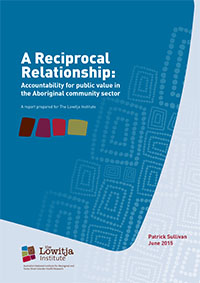A Reciprocal Relationship: Accountability for public value in the Aboriginal community sector
The Aboriginal community controlled health sector is a major provider of primary and preventative health care services to Aboriginal people outside Australia’s major cities and towns. It is important that it functions well. There are many aspects to good service delivery. This paper contributes to one of them—good management—both in the community health services themselves and in the public sector agencies that fund them.
The paper begins by outlining the changing ‘grand narratives’ of public administration over the past century or so among English-speaking countries. It is relevant because they are never completely superseded; some elements of old approaches always survive nested in the trappings of the new. This background also helps our understanding of how things got the way they are, why we do what we do, and how we may be able to do some things better. While this is important for any kind of service delivery, it is particularly so for implementing improvements in Aboriginal health.
The paper then narrows to a discussion of Aboriginal service delivery and how this has evolved through the early years of post-colonial self-determination policy, being taken up by the Aboriginal and Torres Strait Islander Commission (ATSIC), and then the current post-ATSIC environment of contestable service functions.
| Author | P. Sullivan |
|---|---|
| Type | Publications |
| Year | 2015 |
| Download |
 |

